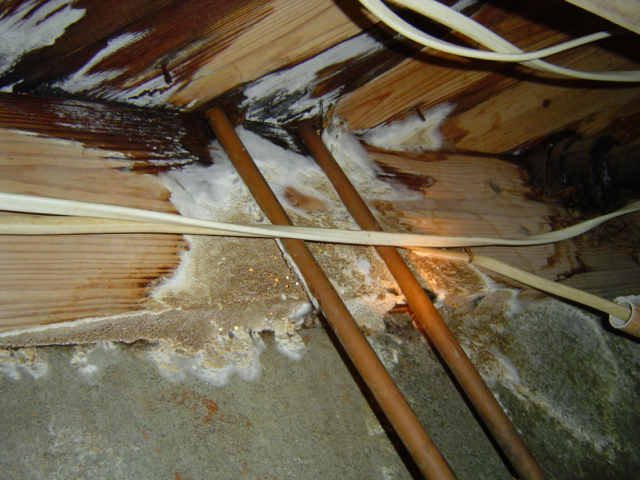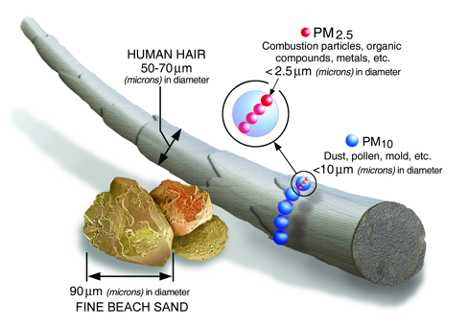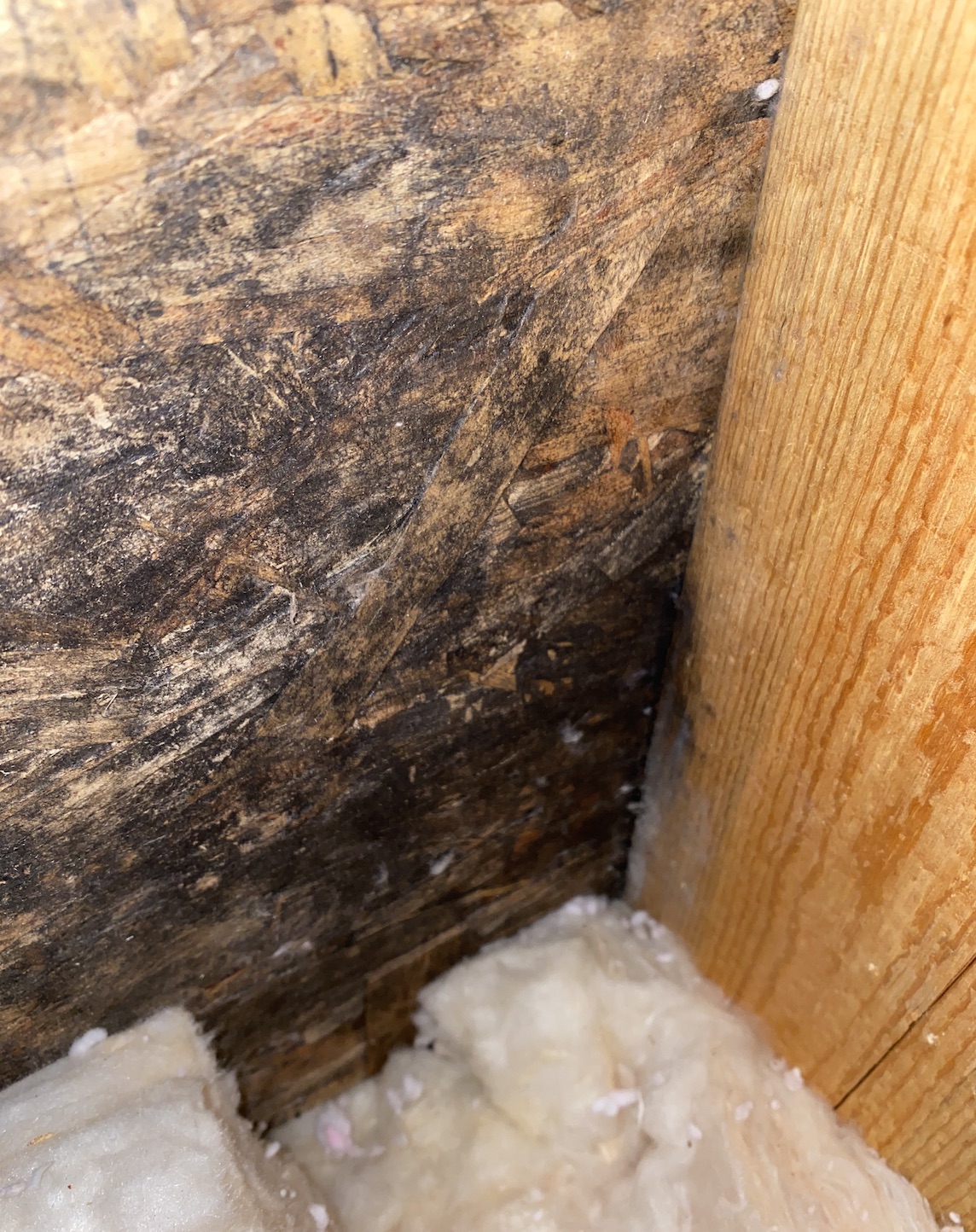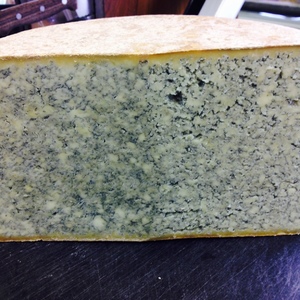Image Credit: Energy Vanguard
Image Credit: Energy Vanguard High humidity in crawl spaces can cause mold to grow on floor joists.
Image Credit: Energy Vanguard Wet, moldy lumber sometimes gets installed in homes.
Image Credit: Energy Vanguard In 2009, some wet, moldy lumber went out to the lumberyards.
Image Credit: Energy Vanguard
I grew up with really bad asthma. Not being able to get enough air into your lungs, in case you haven’t experienced it, is pretty scary. I remember lying in bed during one asthma attack, gasping for air, wheezing loudly, and feeling like I was going to die. A trip to the hospital for a shot opened up my lungs again that night, but I continued to suffer asthma attacks even into my mid-twenties. I’m one of the lucky ones who managed to ‘outgrow’ this debilitating disease, but many live with it every day.
Asthma is often triggered by environmental conditions, and two of the triggers I had to avoid were live Christmas trees and feather pillows. To protect me from the former, my parents got one of those silvery aluminum Christmas trees that are all the rage on ebay now. I also slept mostly on foam pillows, but one night as a teenager, I made the mistake of not telling my friend Guy that I was allergic to feather pillows. Four decades later, he still has vivid memories of his fear that I was going to die that night.
Asthma is bad. Very bad.
The trouble with building science
The reason I’m writing about it here is that I just read a great article called The Trouble with Building Science from the Fine Homebuilding website. (It also happens to be Asthma Awareness Month.) It’s fairly general but does focus on moisture management, or the lack thereof, in homes. I write about that issue a lot, too, and just last week wrote an elementary demystification of vapor retarders.
Here’s the paragraph in the Fine Homebuilding article that spurred my post here:
In the past, experts argued about whether mold posed a serious health threat, but according to a 2007 study funded by the EPA, “Of the 21.8 million people reported to have asthma in the U.S., approximately 4.6 million cases are estimated to be attributable to dampness and mold exposure in the home.” The same study goes on to say, “The national annual cost of asthma that is attributable to dampness and mold exposure in the home is estimated to be $3.5 billion.” Those are just health costs; they don’t include mold remediation. The authors also estimate that dampness or mold is present in 47% of homes.
As a former asthma sufferer, I find those numbers appalling. By not paying attention to the details of moisture management, we’re hurting indoor air quality and people — nearly 5 million of us!
Why is there so much dampness and so much mold growing in so many homes? As architect and building scientist Bill Rose points out in the article, the main source is rain. It comes in through the top, the sides, and the bottom. Plumbing leaks also pose a sigificant risk, and that’s what’s going on in the photo at the top of this article. Water vapor, according to the FH article is third in importance.
A moisture problem caused by the economic downturn of 2008
One source of moisture problems they didn’t mention in the article is building materials that are wet and moldy when installed. Here’s a little secret about that one. If your house was built in 2009 or 2010, it may be more susceptible to that problem.
See those photos of the moldy stack of lumber below? I took them at a building supply store in May 2009, and that whole stack of 2x4s was moldy like this. Why? Recall what happened in 2008. That’s when the economy took a nosedive, and construction went off a cliff. The suppliers couldn’t reduce their production as quickly as demand went down because of the inertia of being so large. The lumber was still flying out of the mill but not being loaded onto trucks and delivered to the lumberyards. It sat out longer than usual, getting wet and then starting to grow the kind of stuff you see in the photos. I have no idea how much moldy lumber got put into new homes that people are now living in, but I do know that it was getting delivered.
A solution?
It’s time for the construction industry to get serious about moisture management. If everyone responsible for building homes got to experience the feeling of a bad asthma attack, maybe it would happen more quickly.
Weekly Newsletter
Get building science and energy efficiency advice, plus special offers, in your inbox.
















6 Comments
mold
Just wait until we adopt the 2012 IECC. If adopted as currently written with exterior foam and R-21 of fiberglass in the walls combined with a very low ACH, I predict a mold epidemic. Unless they require HRV's that remove moisture, we will get mold somewhere in the walls or in the house.
Response to Anders Lewendal
Anders,
Neither high-R walls nor tight building construction causes mold.
Plenty of old houses with low insulation levels and leaky walls have mold, while most high performance homes with high-R walls and low rates of air leakage are mold-free.
If you have mold, it's because of water or high humidity.
But how to beat it?
I've seen so many sources of mold and moisture: leaks under sinks, roof or wall leaks from failures or poor flashing, cold condensing basements, rising damp, excess humidity in a bathroom, and mold behind a chair (perhaps from chair creating a cold spot on an uninsulated wall in a humid room?).
Most of these can be solved, at least in theory, with good technology: mech venting, dehumidifiers, insulation, and correct use of vapor barriers.
But what about roof failures, plumbing leaks, leaks in the envelope where condensation builds up, and the like? Are there good solutions? Maybe distributed sensors that will pick up elevated moisture and give warning? Perhaps smarter ventilation/humidity control systems? Perhaps materials that absorb moisture without damage or do not absorb it at all?
Mold is one specific failure symptom, but is it possible to design a home in which there are no major weak points, where the inevitable failures in construction or materials etc are caught quickly & repaired easily or are unimportant to the effectiveness of the house as an efficient, comfortable, safe, and healthy place to live?
Pondering....
Well, perhaps it is something to ponder...
Feature of a pretty good house
Dustin, I think that is a very good point that should be added to the list of what constitutes a Pretty Good House (PGH).
How do you get rid of it
How do you get rid of it without replacing the mold with chemicals? I've been building a house for just about 3 years, and am just now beginning to sheath my roof. It's hard enough to come up with $$ to survive, let alone build a house out of pocket. Needless to say, the house --full basement (half above grade), 1st, and 2nd floors, have been exposed since its birth in 2009.
The good news is that with the exception of the roof, the entire building is icf, concrete floors, and steel joists/decking. The bad news is that my house resembles an abandoned structure, musty, damp in the basement and first floor with basically permanent water (from rainfall having no way to completely dry). I also used an ICF with mineral wool inserts, which I know have some mold issues. There is no way to get to the mineral wool, as it is an internal component of my concrete filled walls.
I could not afford another concrete deck (the original roof plan), so I broke down and decided the only way I could finish the envelope was to use wood. The roof sheathing was bought used, and my rafter lumber was bought at auction. In both cases, the material had been exposed to an undetermined amount of weather. There is definitely visible mold on a small, but decent portion of my material, and virtually all of it is wet , even slimy, between boards; however, I have no choice but to use these materials.
I was planning on an unvented cathedral ceiling, 2-3 inches of closed cell spray foam on the underside, and 4 inches of rigid xps between 2 layers of 5/8 CDX on the roof. I have been wondering about how I will get internal moisture out of my house if not through the roof. Also, I am assuming that I will be trapping mold and whatever moisture content is in the lumber forever between the exterior and interior closed cell insulations.
Any thoughts in terms of cleaning the musty, wet, moldy building, and dealing with my roof?
Response to Deniz Bilge
Deniz,
As you are now aware, you made several errors. Although you apparently hoped to save money by avoiding hiring a contractor, your 3-year building project has resulted in a very damp house. It's quite possible that you are about to discover that your plan to save money won't really save you any money. If your house is a damp mess, your savings are illusory.
In other words -- there is a reason that professional contractors work quickly to get a roof on a new house -- especially if they are working in a damp climate.
My own advice: work with all deliberate speed to get your roofing installed. Then leave plenty of time to dry out your house before beginning any finish work. You're going to need to use a trash pump to empty your basement, followed by several weeks with window fans operating, followed by several weeks operating rented dehumidifiers. Even then, you could easily have lots of problems.
Good luck.
Log in or create an account to post a comment.
Sign up Log in